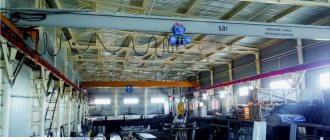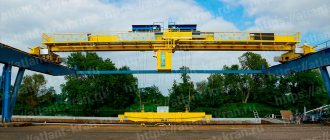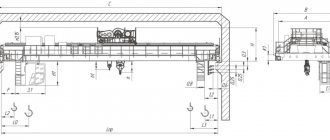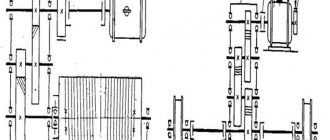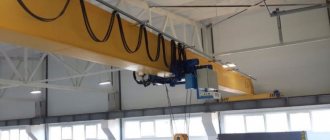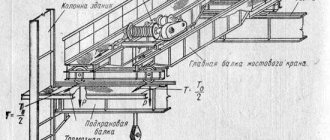Single girder crane span
Single girder overhead cranes are very simple and versatile, with a low lifting capacity.
Single girder overhead cranes are very simple and versatile, with a low lifting capacity. If a single girder crane and a double girder crane are exactly the same and have the same lifting capacity, then the single girder crane will be much lighter. The metal structure of all cranes and single-girder cranes also depends on the size of the span and the amount of cargo lifted.
If the span is small, then the metal structure will have one beam, which is connected to the end beams.
The crane movement mechanism is located on one of the end beams. This mechanism is connected to another beam using a drive. If there are large spans, in addition to the main beam, there is a spatial structure. The electric hoist moves along the lower beam and is controlled from the floor. The crane, which has a long span, moves along both end beams.
Suspended single girder cranes rest on their wheels. Depending on the span length, they can be double-supported or multi-supported. Suspended cranes have the ability to cover a large area with work. Suspended spans that are located close to each other can be connected. Thanks to this, the electric hoist can easily move from one place to another.
Support
The single-beam support unit allows you to move loads weighing from 5 tons to 10 tons. This is a powerful technique designed for medium and large industrial enterprises. It is installed in warehouses and workshops. It is widely used in metallurgy and mechanical engineering.
Cranes are in demand at enterprises operating in the food and chemical industries. This is a universal-purpose lifting device for working with loads weighing up to tens of tons.
Enterprises often install support crane beams in their workshops, placing them in tiers. At the bottom there are cranes that have a small lifting capacity. They are designed to serve workplaces or local areas in production.
The upper tiers are equipped with installations that allow the movement of large loads. They work throughout the industrial site, covering the lower tiers. With their help, they perform loading and unloading, installation and dismantling work.
The equipment is easy to adapt to a room of any size; When choosing an installation, its area and purpose are taken into account. If the installation is done correctly, then 1 crane serves the entire enterprise. Support cranes operate in open and closed areas, in difficult weather conditions and with sudden temperature fluctuations.
Double girder crane span
The double girder overhead crane consists of a main girder and end girders. The bridge moves along the tracks. These tracks are located on the crane beams. A trolley moves along such a bridge, which contains almost all the mechanisms located in the crane. Such cranes also have their own spans, which are equipped with observation platforms. These platforms are intended for inspection of the crane, as well as for troubleshooting problems that have arisen in various mechanisms of the crane.
A double girder crane consists of a main girder and end girders. The bridge moves along the tracks. These tracks are located on the crane beams.
Cranes, depending on what they are intended for and what work they perform, they are classified into grab, magnetic and others. In addition to general purpose cranes, there are special purpose cranes that are used in a narrow area of industry. For example, cranes that are designed only for lifting heavy loads, or only for moving them.
Overhead stacker cranes are widely used in warehouses for loading, unloading, and moving packaged cargo.
Stacker cranes are available: supporting and suspended, with and without a cabin, with a supporting and suspended trolley, with manual and automatic control. Such cranes can be controlled both from the cabin and using the remote control.
The design of the stacker crane consists of a bridge, along the lower edge of which a trolley moves. The cart has a platform that rotates. Special columns are attached to such a platform, which absorb the load and volume of the load being lifted. Such cranes have several directions of movement, and have two drives for movement.
The advantage of such cranes is that they can be used in warehouses, in narrow aisles, they can lift the load quite high and have high productivity. The main disadvantage, and perhaps the only one, is the large mass of the crane itself and the complexity of the automatic mechanism.
The spans of overhead cranes must be installed in accordance with GOST. When installing spans, it is necessary to take into account the width between the buildings where the spans are installed, and it is also necessary to take into account the width of the passages. These passages are necessary for inspection and, if necessary, repair of crane mechanisms.
Classification
Overhead cranes are used to lift and move large, heavy loads in all areas of human industrial activity.
The technical characteristics of overhead cranes allow the use of this category of hydraulic lifting equipment both for internal loading and unloading and for external work in any climatic conditions.
The disadvantage of GPM bridges is that they are stationary, but the advantage is that they can use the construction height of the building.
Bridge PMGs are divided into 2 large groups: general purpose and special.
Bridge OPI (general industrial design) are equipped with a cargo hook.
Special - equipped with grips that have a highly specialized purpose: grab, magnet, grips for containers. Special lifts appointments are made with a rotating trolley or boom.
A separate group includes metallurgical gas-and-metallic machines intended only for this industry. Such GPMs are equipped with special equipment. grips: foundry, forging, for stripping ingots, etc.
General rules for installing spans
- The spans of overhead cranes must be connected with the spans of buildings;
- If the width of the bridge crane span does not exceed the length of 23 meters, then only one path is laid;
- Span cranes must have their own gradation, which must be created in accordance with the standards.
Standards for grading overhead cranes were created in order to establish the interchangeability of cranes. This is very necessary for industrial plants that use cranes. Sometimes in production it is necessary to change the crane span. To do this, you need to know that if the crane span is increased, then this crane will be able to lift loads much lighter than those that it lifted before increasing the span.
But still, if there is a need to increase the span of the crane, but leave the load capacity the same, then it is necessary to carry out special calculations, which are carried out when installing the metal structure. If the span is reduced, the ability to lift loads will remain the same as before the span was reduced. Of course, such work can only be entrusted to professionals and workers who have extensive experience in carrying out such work. Since such work must be carried out in accordance with standards.
